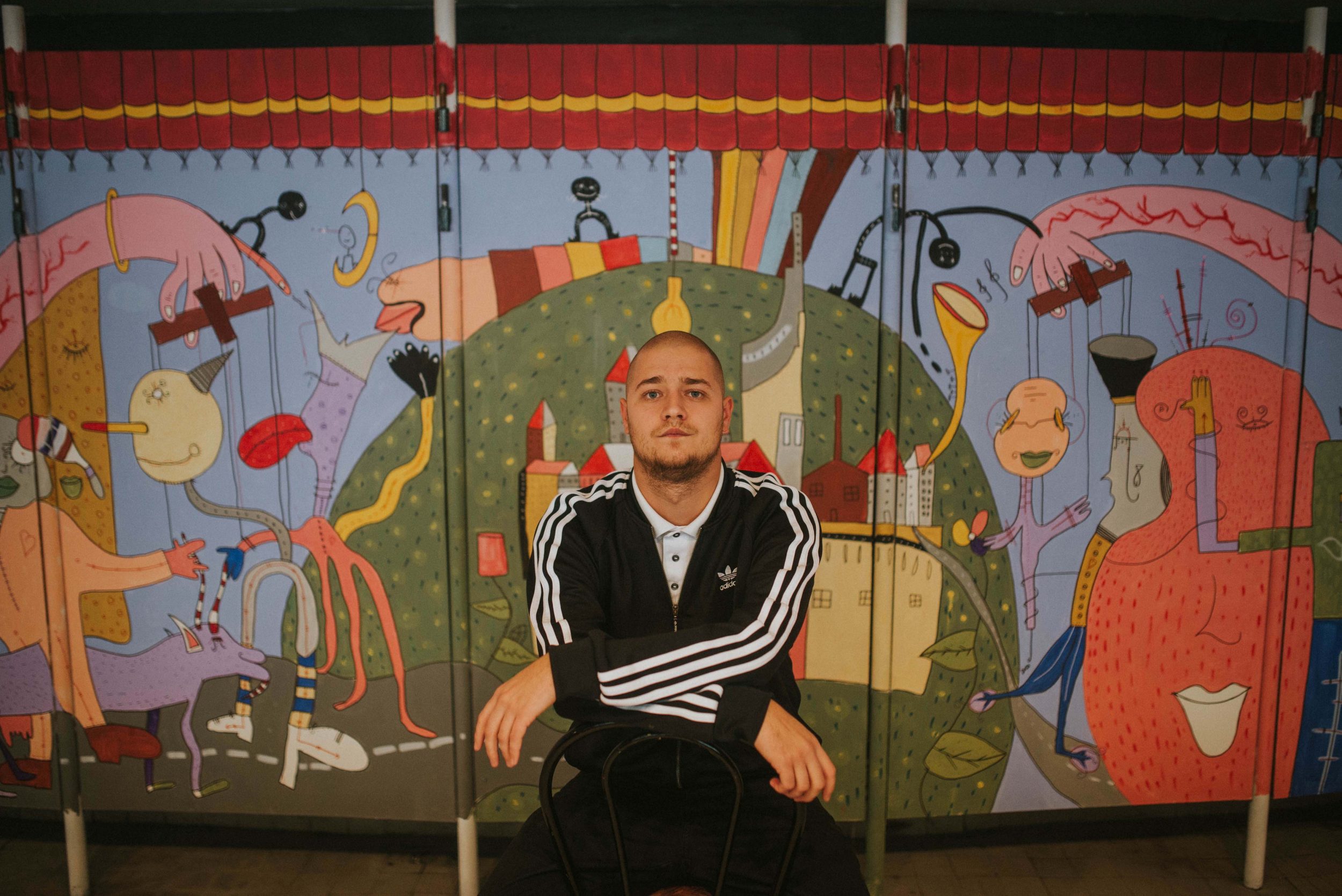Rikardo Druškić is one of Sarajevo’s most promising artists – and a child of the post-war generation who tries to make sense of a past he has no memories of.
Rikardo Druškić rearranges the two mobile phones and his wallet like cards on a casino table. One next to the other, no spaces in between, edge to edge. He does that a few times while drinking a beer in the bar at the Academy of Performing Arts, one of his favourite places in Sarajevo. Moving and rearranging – it is Rikardo’s way to release his nervous energy and to bring order into the chaos at the table in front of him. It is also his way to make sense of the world around him as a visual artist. „Without art I would go crazy,“ says the 27-year-old.
The light in the bar is dim; a few students from the Academy are sitting around, smoking, drinking, coming and leaving every 30 minutes. It is early afternoon and everybody is in between things to do. People greet each other briefly, have a chat and then mind their own business. The bar is a small place where you cannot hide in a corner. But with the sparse light and cigarette smoke you do not have to come too close to anyone if you do not want to.
VIDEO: “I think Sarajevo deserves better art”
Rikardo is a tall young man with hands that look like they are used to physical work. But as soon as they are holding a pencil or a spray can, his hands mix rawness with elegance. In an Adidas sports jacket his long fingers look like a natural extension of the stripes on the sleeves of the jacket. There is a flow in his appearance. At the same time he conveys a disruption on the inside. Both parts put together make up the source and the style of his work as an artist.
In 2014 his piece „Madness Continues“ was a finalist at the „Art Revolution Competition“ in Taipei, Taiwan. This award put him on the art map outside of Bosnia and launched his career. Since then he was part of exhibitions in New York, Miami and Berlin. But Rikardo is also a child of the post-war generation.
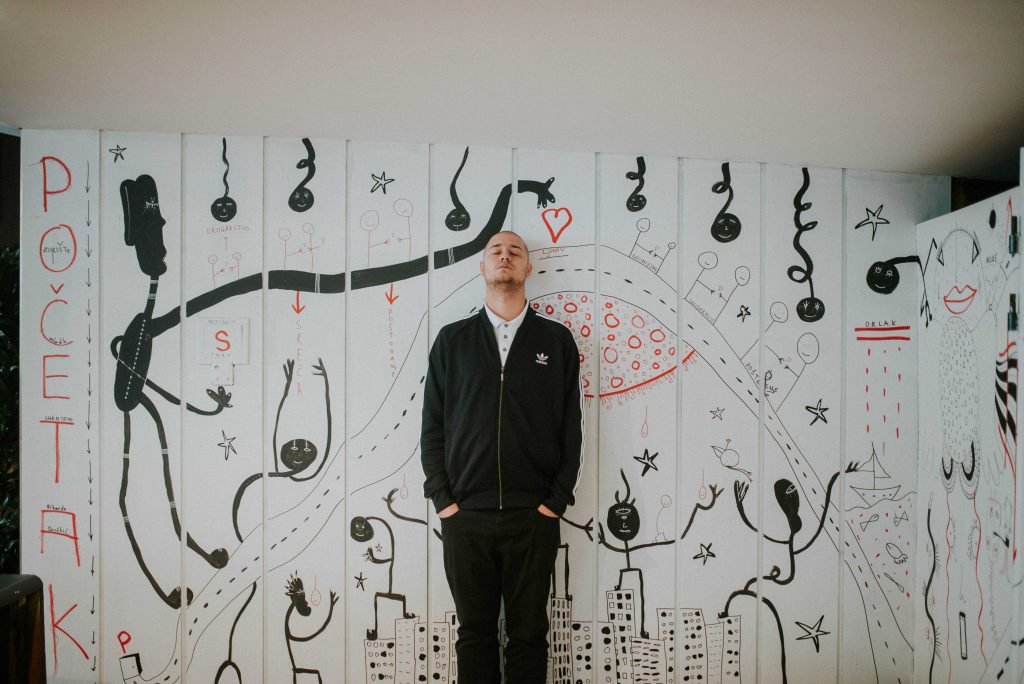
Figures, scenes and playfulness: Rikardo’s work at Pozoriste Mladih Sarajevo (Youth Theater Sarajevo, Kulovića 8)
He was two years old when the war in Bosnia broke out and spent the years during the siege of Sarajevo (1992-1996) in the city with his parents. During this period Sarajevo was under constant attack from the Serbian paramilitary forces. Few people were able to leave the city and close to 14,000 were killed.
Rikardo has no memories of that time. But he says it had a huge impact on him. „I am nervous a lot and I am sure that is because of the war.“ Sarajevo is a city with tension and low energy, he says. People are struggling with poverty, high unemployment and a political system that did not move the country forward since the Dayton agreement ended the war more than 20 years ago. „It is hard here for people to be themselves because they are always stressed out about how to take care of their family.“ Therefore, says Rikardo, the city is cocooned with a sense of restlessness with people being always on their toes.
„I don’t really want to talk about it. Something has ended at that time and something new was about to begin.“
Rikardo’s view on Sarajevo also holds true for his work and himself. His nervous energy that shows in him rearranging phones and wallets also shows in his drawings and paintings. Both are a coping mechanism. And a form of self-protection from unpleasant experiences – personal and as a society. One of his paintings, „The Beginning“, hangs on the wall at the bar in the Academy of Performing Arts. „The Beginning“ is a piece with warm colours, inviting at first but also scary displaying fishes whose heads have been cut off and awkward looking figures. The painting deals with a transition period in his life. „I don’t really want to talk about it. Something has ended at that time and something new was about to begin.“ Rikardo wants the painting to speak for itself. To open up and explain his emotions linked to the painting would make him too vulnerable. It is easier and saver for him to put his inner feelings out there without explanation and move on to his next work. The viewers shall find out for themselves. The human being behind the painting prefers to remain in the shadow.
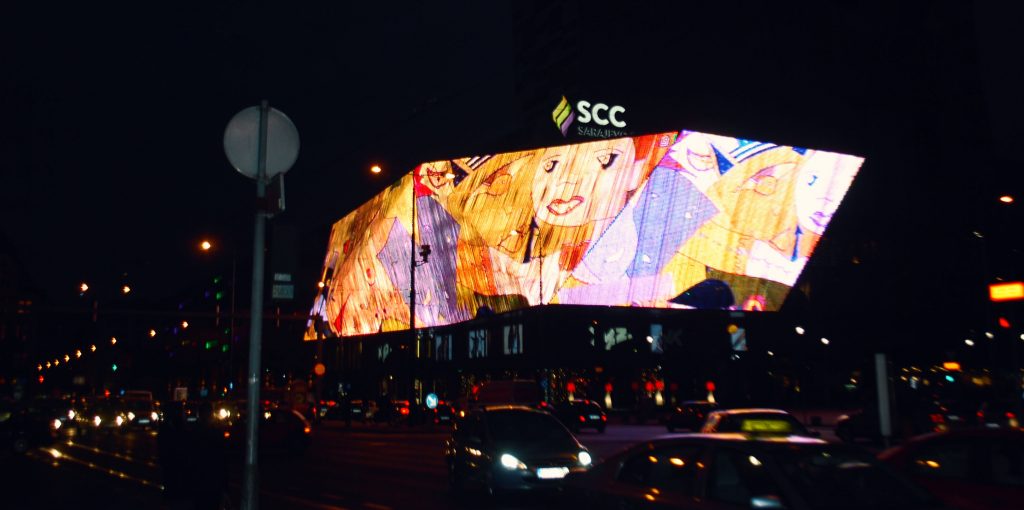 Street Art in a different sense: Screening of Rikardo’s work at the SCC Shopping Centre in Sarajevo
Street Art in a different sense: Screening of Rikardo’s work at the SCC Shopping Centre in Sarajevo
With his short hair, rolling gait, hooded sweater, sneakers, ample trousers and nervous glance in his eyes Rikardo comes across like a football fan on his way to a game – ready for a fight. But when he smiles his face reveals an innocence that is both welcoming and withdrawn. Instead of fighting, Rikardo channels his energy and dark side into his art. „Madness Continues“, „Fear and Loathing“ or „Dark Side of my Room“ are titles of his paintings. The later being about a darkness inside that you cannot show to people in public but only in your room when no one is watching.
His work attempts to connect the dark side of his room with the outside world. The restlessness of human beings with a place quieter and at ease. The past wounds of a society with a more compassionate future. Sarajevo might be the environment in which Rikardo’s art originates, but it conveys something universal about contemporary life. His approach is playful and his figures appear childish at first. But the many movements, characters and twists in his paintings calm down the viewer in a strange way. It is almost like someone has visualized and colored our own fears, restlessness and short moments of joy in order to give us some time to relax.
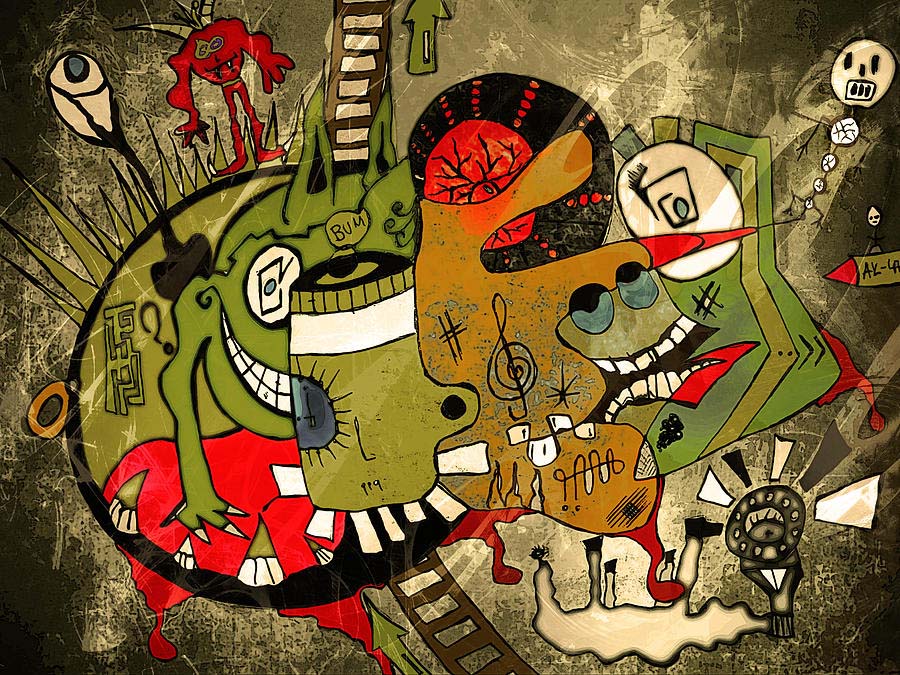 Kicked off his career: The Madness Continues
Kicked off his career: The Madness Continues
The 27-year-old is not interested in art history, but the recent past of his country clearly shows in his art. „I am simply expressing my inner feelings and share them with the audience. When you see my work you feel some emotions.“ He started to draw when he was still in high school, but did not seriously produce works of art until he was in his early twenties. In his hometown Sarajevo Rikardo has done commissioned work for theatres, shopping centres and car companies. Besides his around 400 paintings – most of them are drawn by hand, colored and then printed digitally – he has also created several murials.
Opportunities in Sarajevo are rare and it is hard for artists to make a living. Public support is low and the complicated political structure with two separate entities in the country (The Federation of Bosnia-Herzegowina and The Republika Srpska) prevents a proper funding system to emerge. „There is a lot of jealousy and artists don’t support each other. If you get a chance it might be your only one. So people are getting weird about it. It is like in all poor places: People who make it do so somewhere else – in Europe or the United States. But not here.“
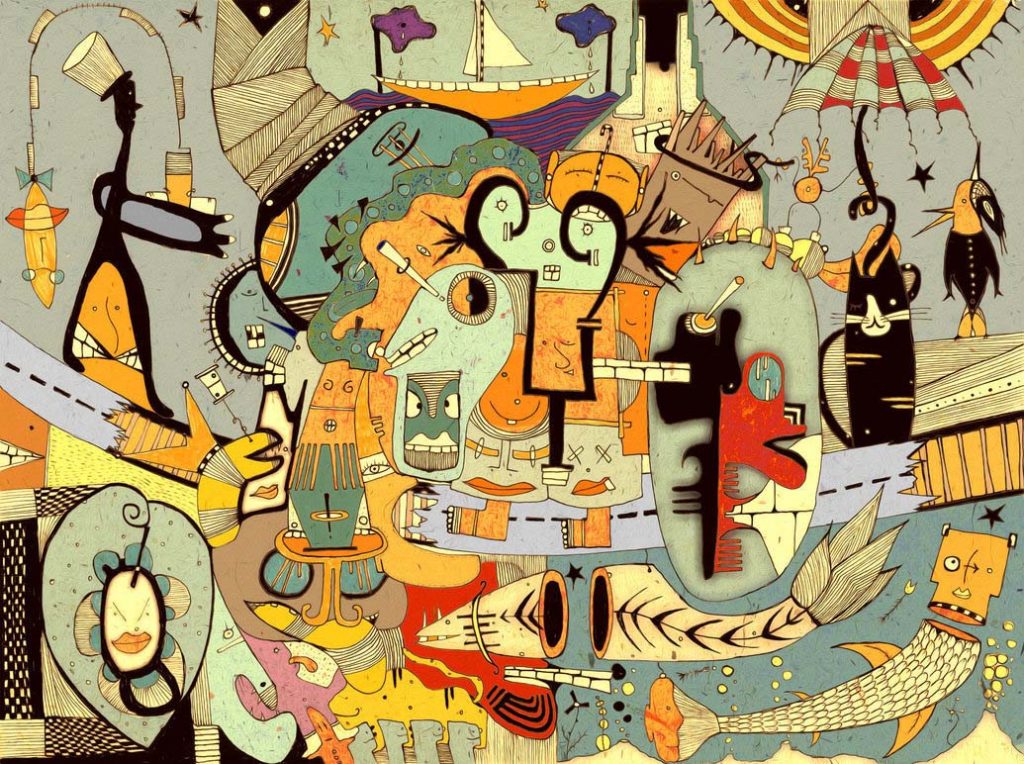 Hangs on the wall between smoke, beer and talks at the bar of the Academy of Performing Art: The Beginning
Hangs on the wall between smoke, beer and talks at the bar of the Academy of Performing Art: The Beginning
Since the end oft he war in 1995 approximately 150,000 young Bosnians have left the country, in 2016 youth unemployment according to the World Bank was 68 per cent. Unlike many others of his generation Rikardo has no plans of leaving Sarajevo. „I am lucky. I can do what I love, earn a living, be with my friends and family and travel around.“ His paintings sell and his commissioned work for companies brings additional money and attention. But the 27-year-old is still enjoying the luxury of living with his parents and has no plans of moving out until he has his own family. These circumstances are helpful for fully focusing on his art and career.
Despite his own success, his outlook on the future of Bosnia is not very optimistic. „I try to contribute with my art. I am glad if people enjoy my work and feel connected. But one gallery or one exhibition is not enough. Sarajevo deserves more art but people don’t dare to demand more. We still have this attitude in Bosnia: it is all good, at least we are alive. Just please don’t shoot us.“
About 45 minutes after sitting down at the bar Rikardo has finished his beer and picks up his mobile phone and wallet from the table. It is time to move on and to rearrange them anew in some other place – and to continue to make sense of the world around him.
Right at the river and one of the best bars in town: The Academy of Performing Arts in Sarajevo
The city: Sarajevo
During the 1980s the city known for its religious and cultural diversity experienced a decade filled with exciting sporting events, flourishing art scenes and a vibrant urban life. But the war brought this development to an abrupt end only a few years later. During the siege of the city, 11,541 people lost their lives, including over 1,500 children. An additional 56,000 people were wounded. Today, the capital of Bosnia and Herzegowina is slowly recovering and has a population of about 275,000.
The country: Bosnia and Herzegovina
The country declared independence from Yugoslavia on March 3, 1992. The following war killed more than 100,000 people and was ended with the Dayton agreement on December 14, 1995. Since then economic and political progress has been slow. Since the end of the war approximately 150,000 young Bosnians have left the country, and around 10,000 young people still leave the country each year.
In 2016 the unemployment rate was about 25 percent. Youth unemployment was even higher than 65 percent. Bosnia has a population of approximately 3,5 million people with an average salary of around 400 Euro. The political system of the country, which has been based on ethnic identity since the war, is considered to be one of the world’s most complicated systems of government.
